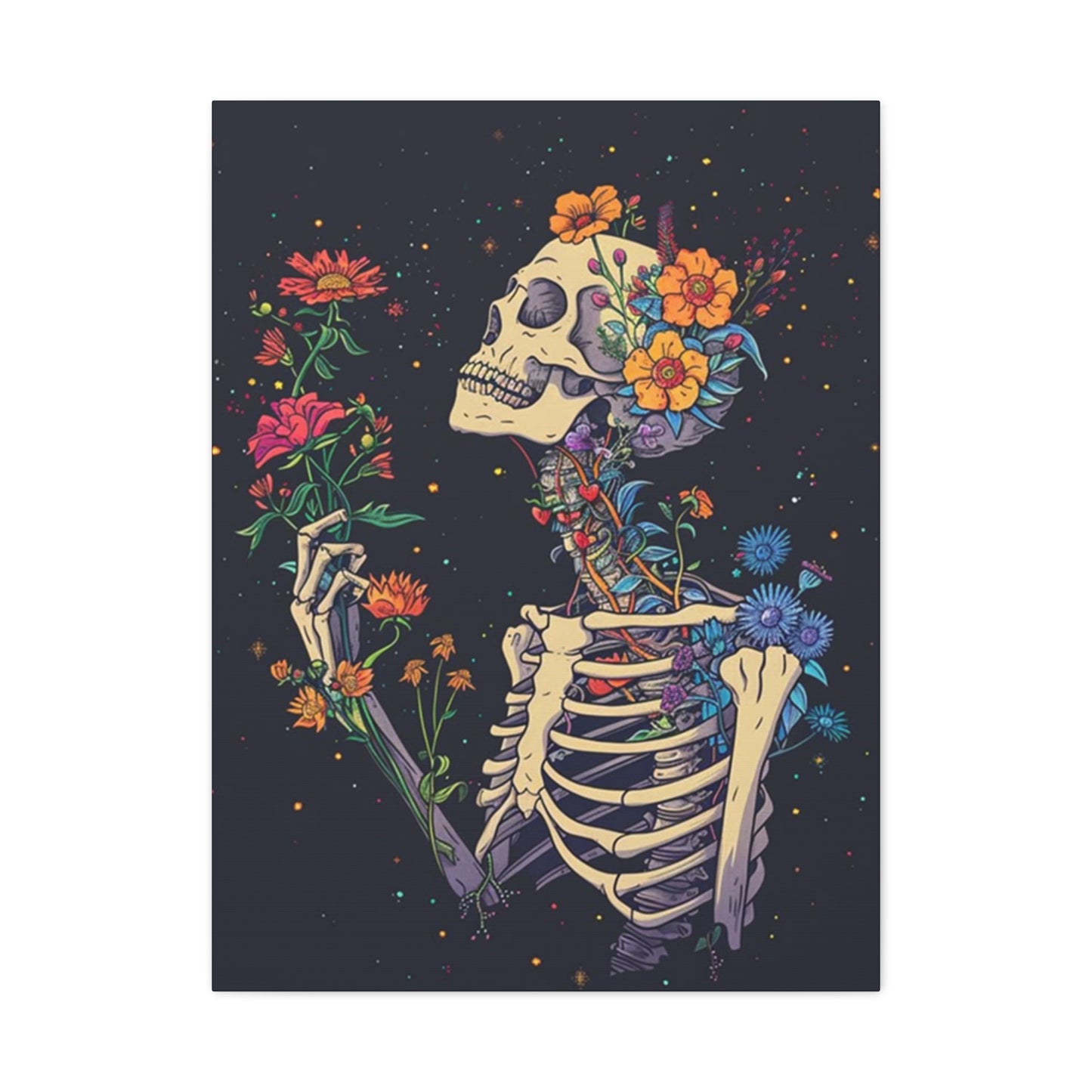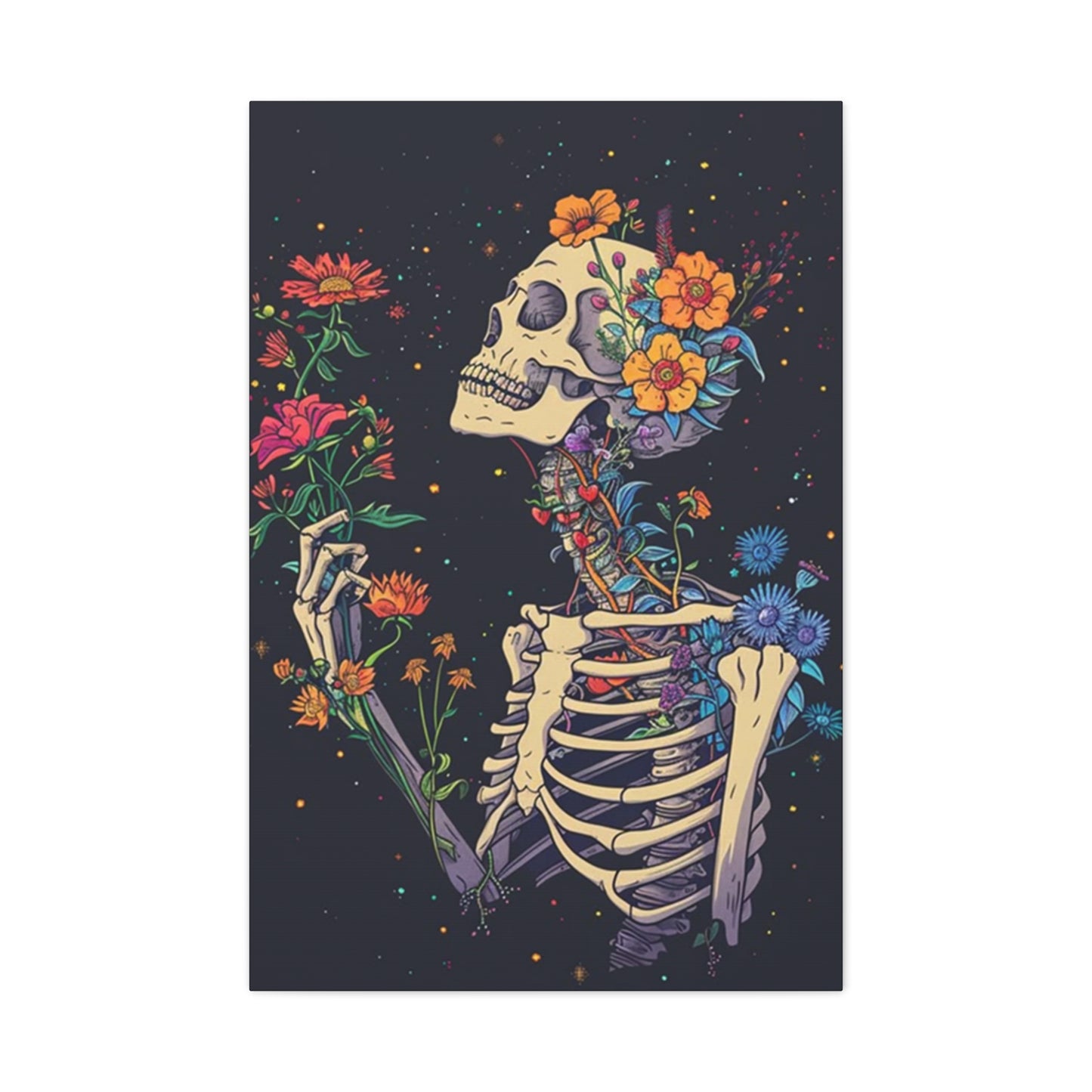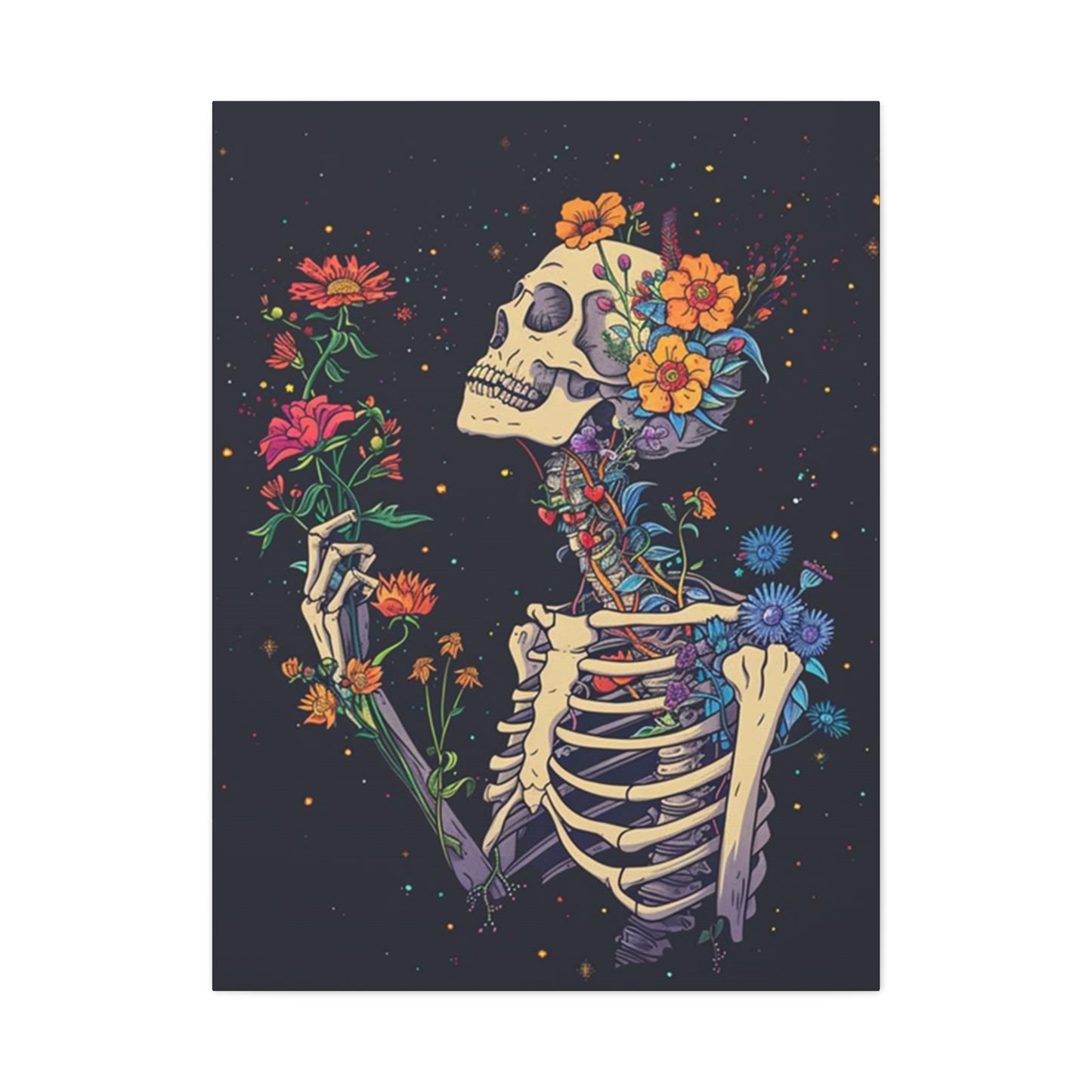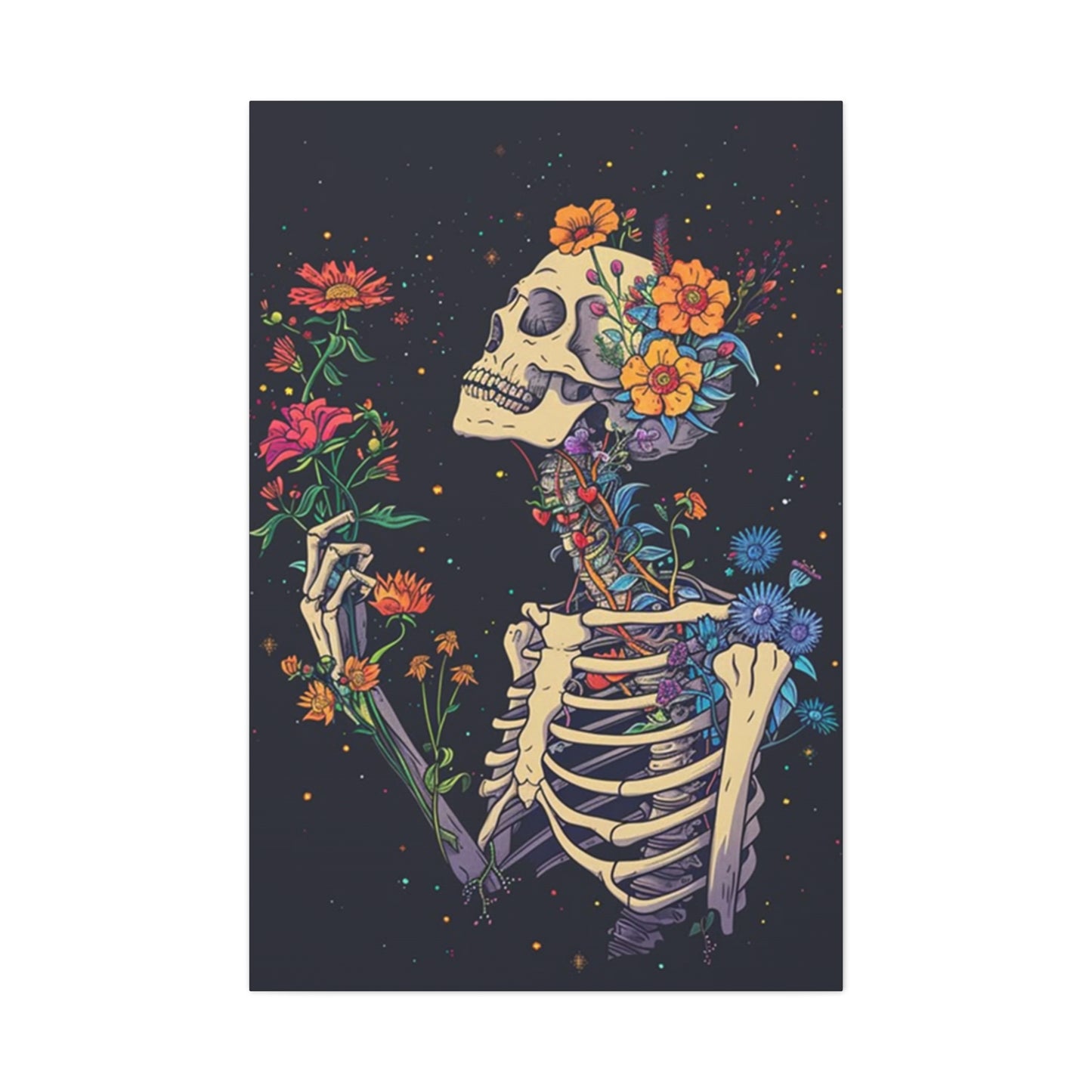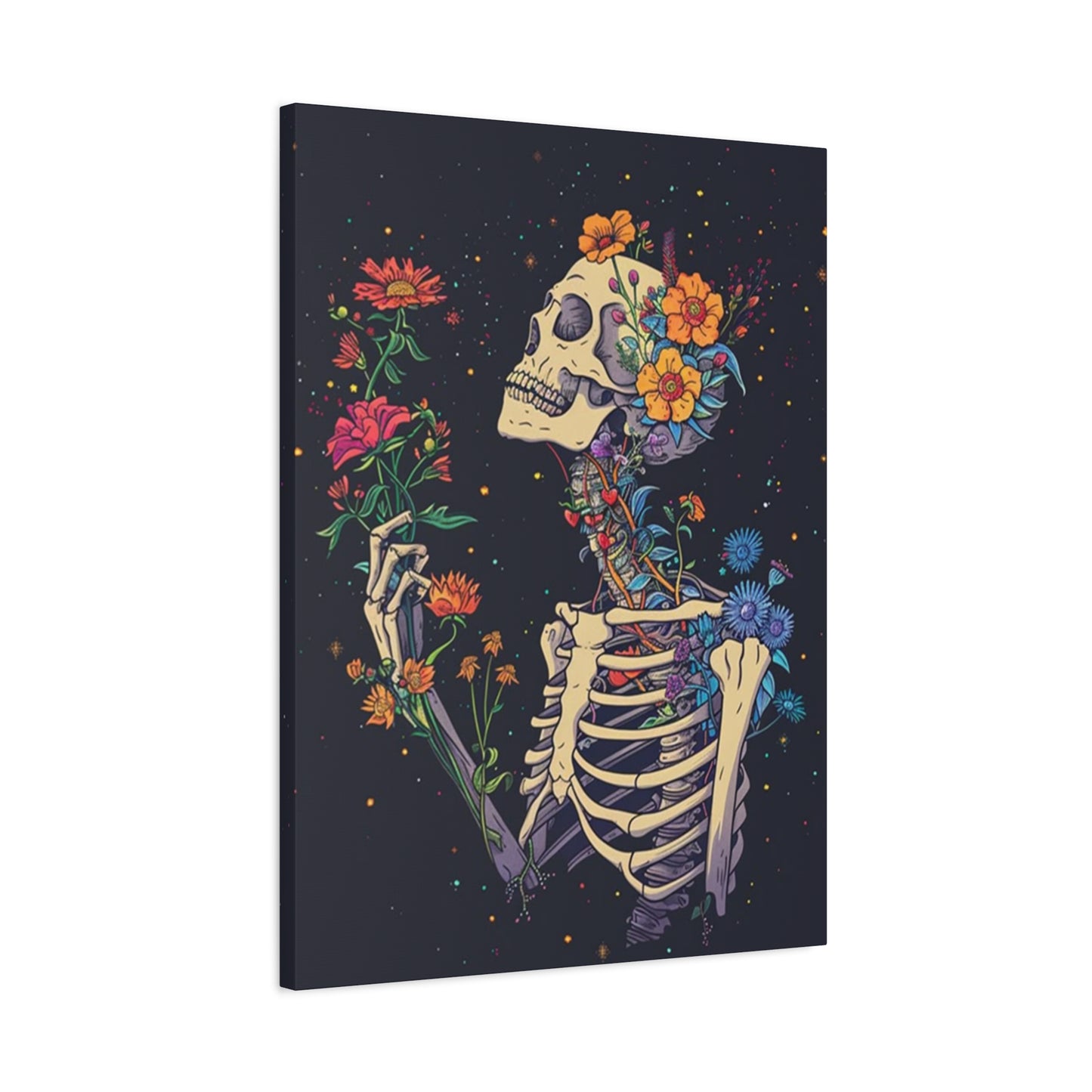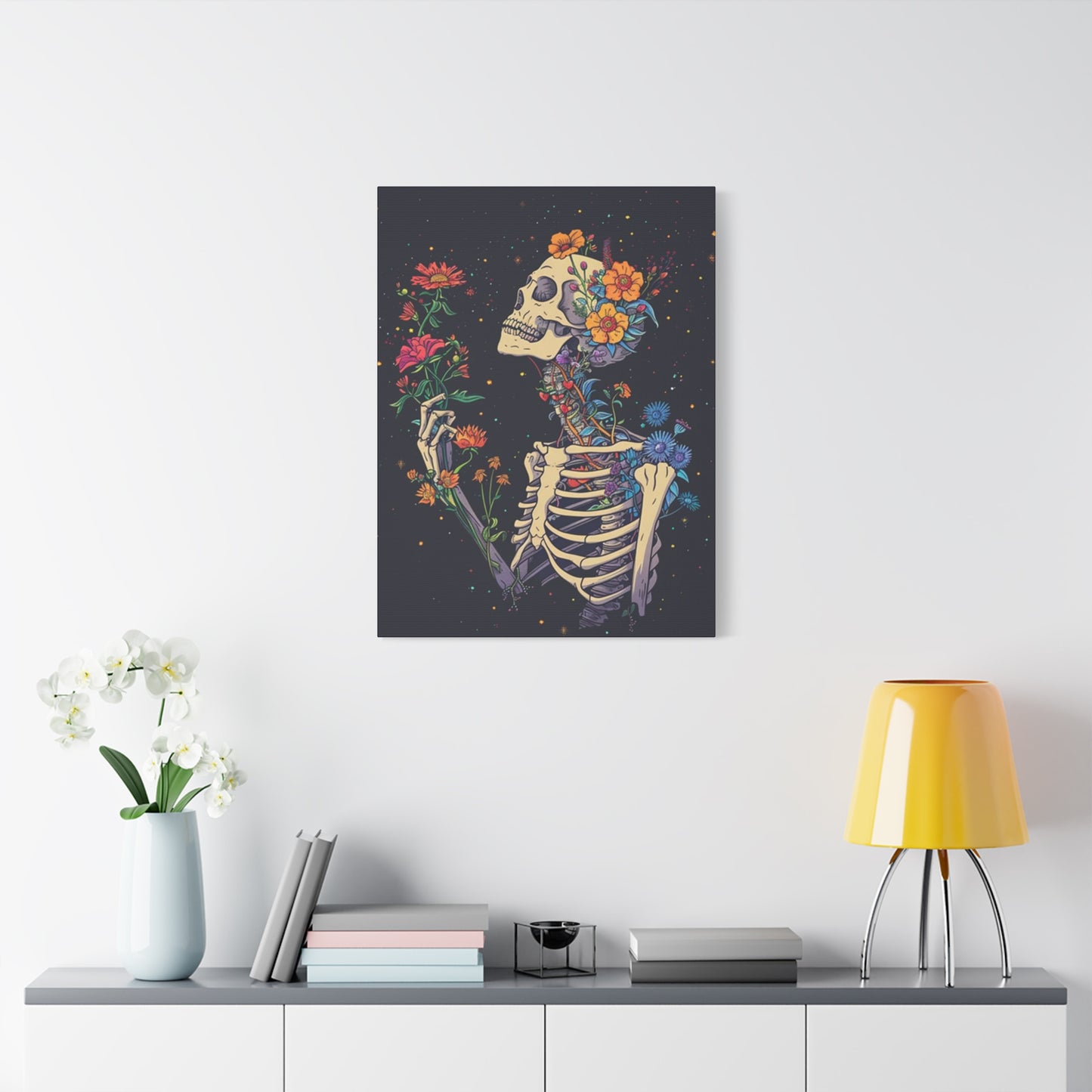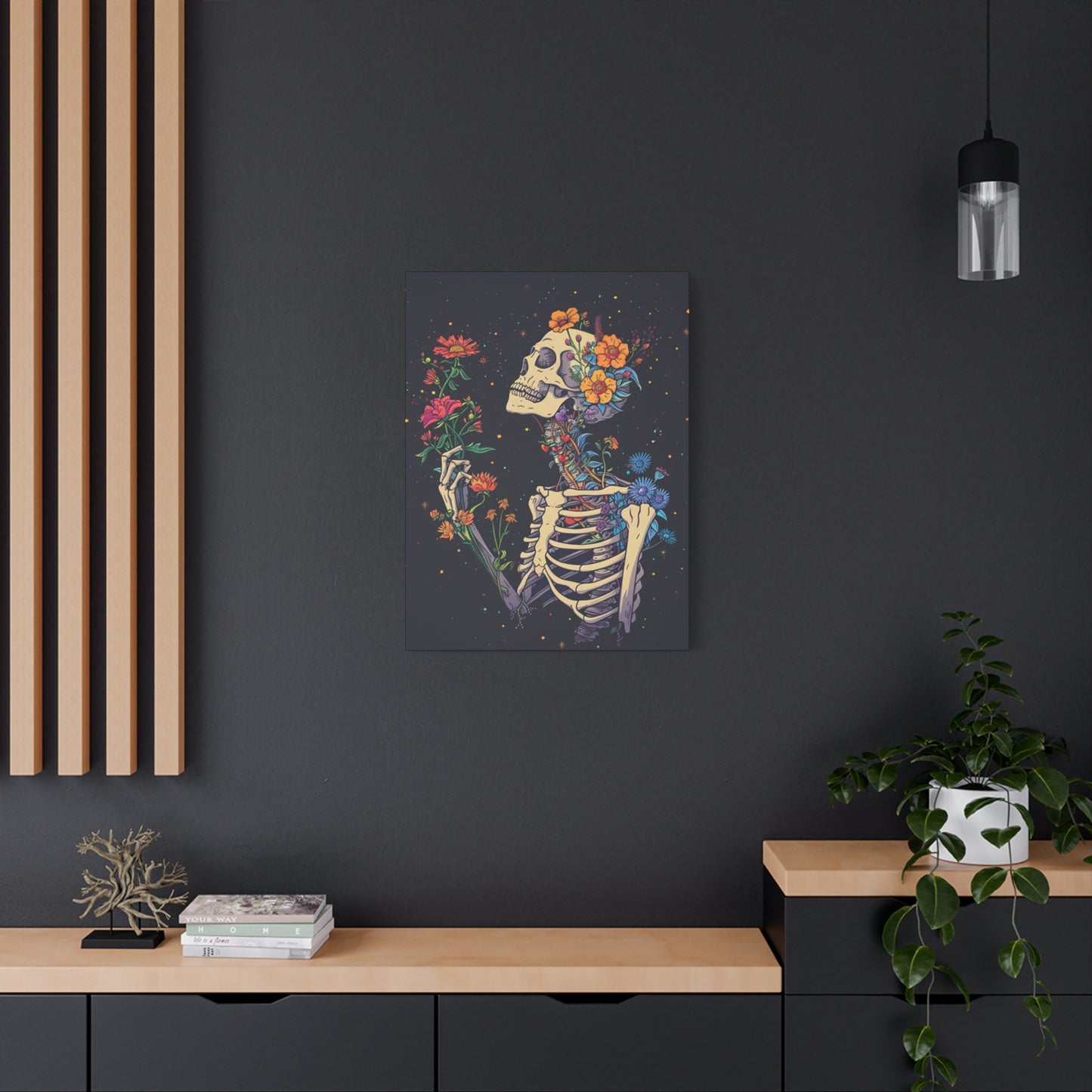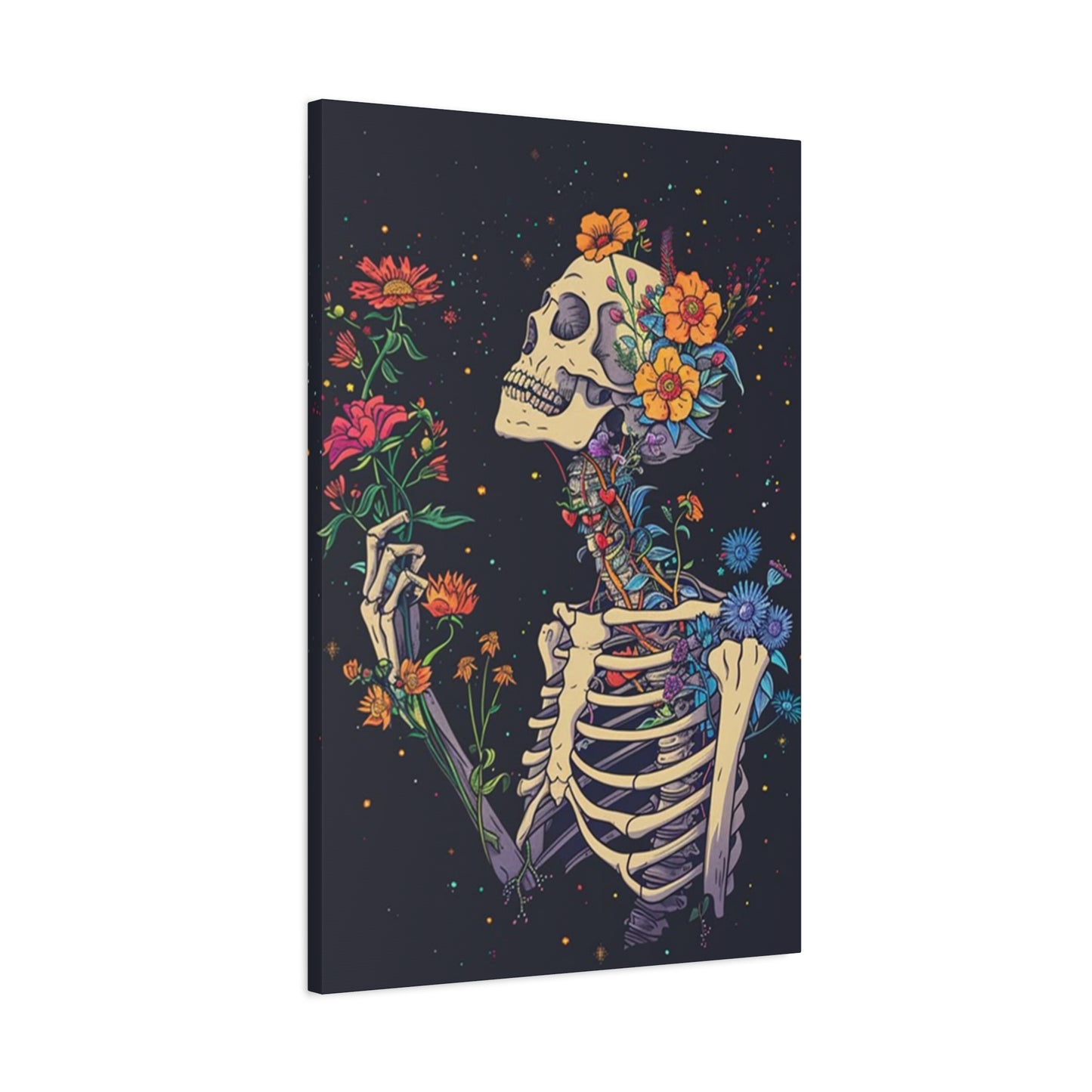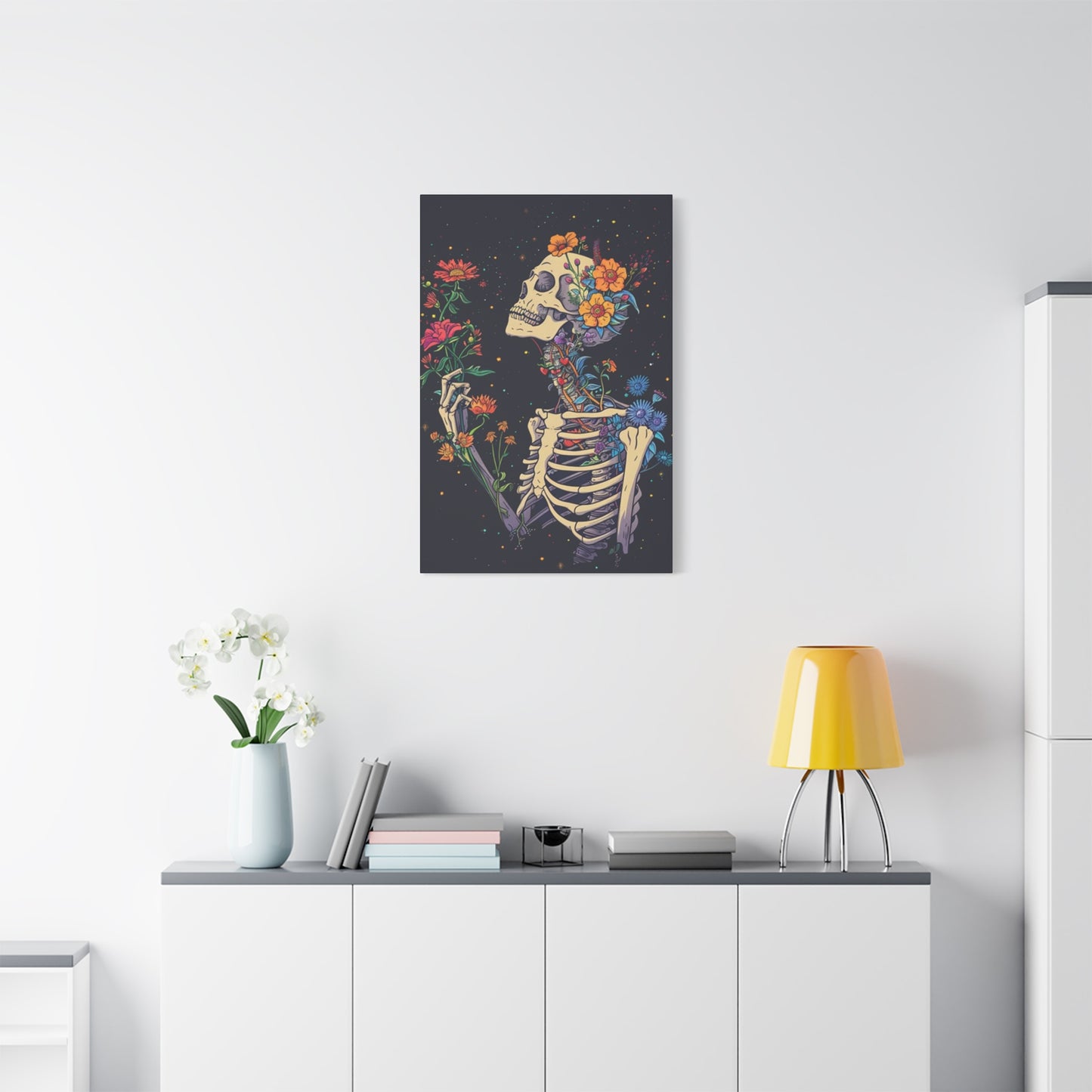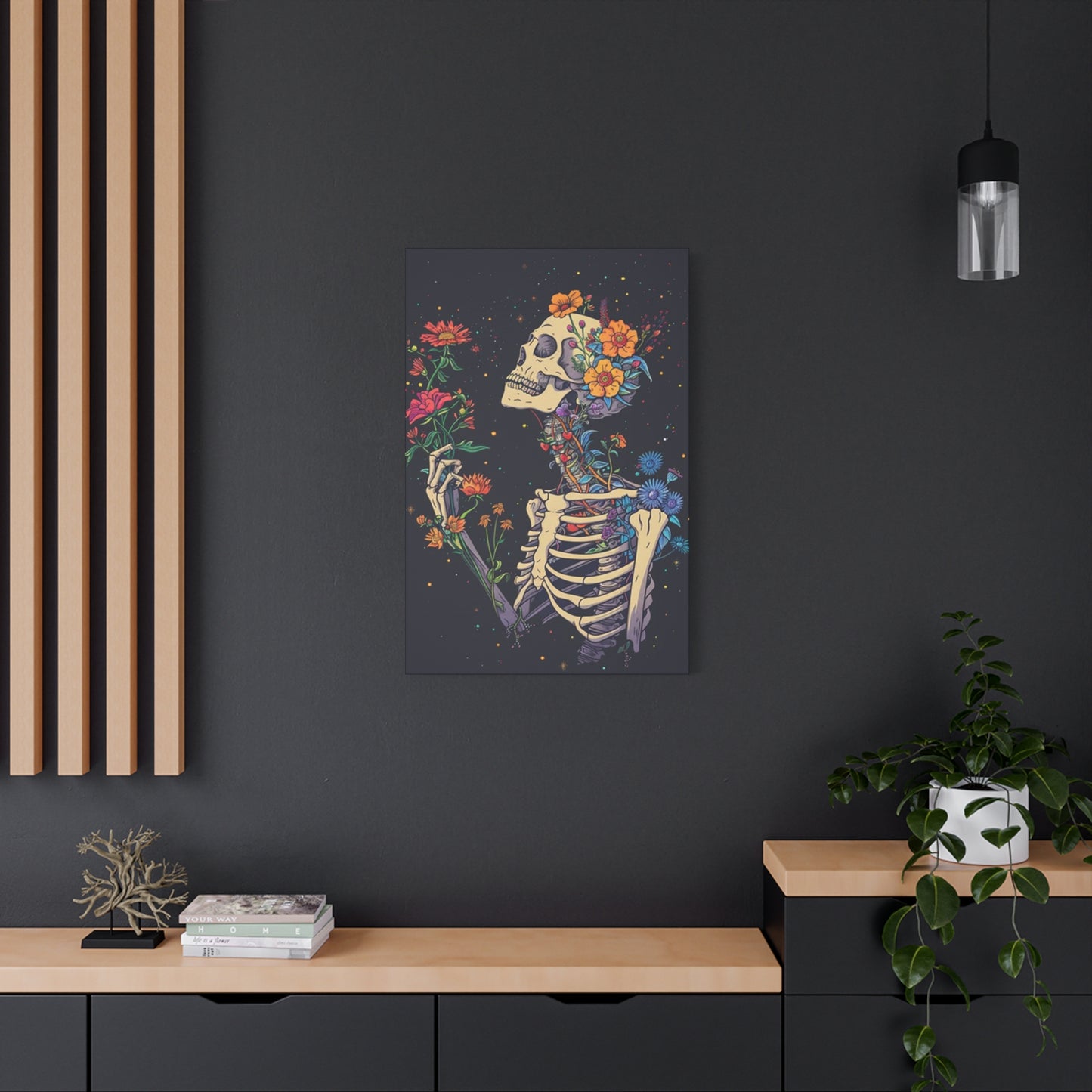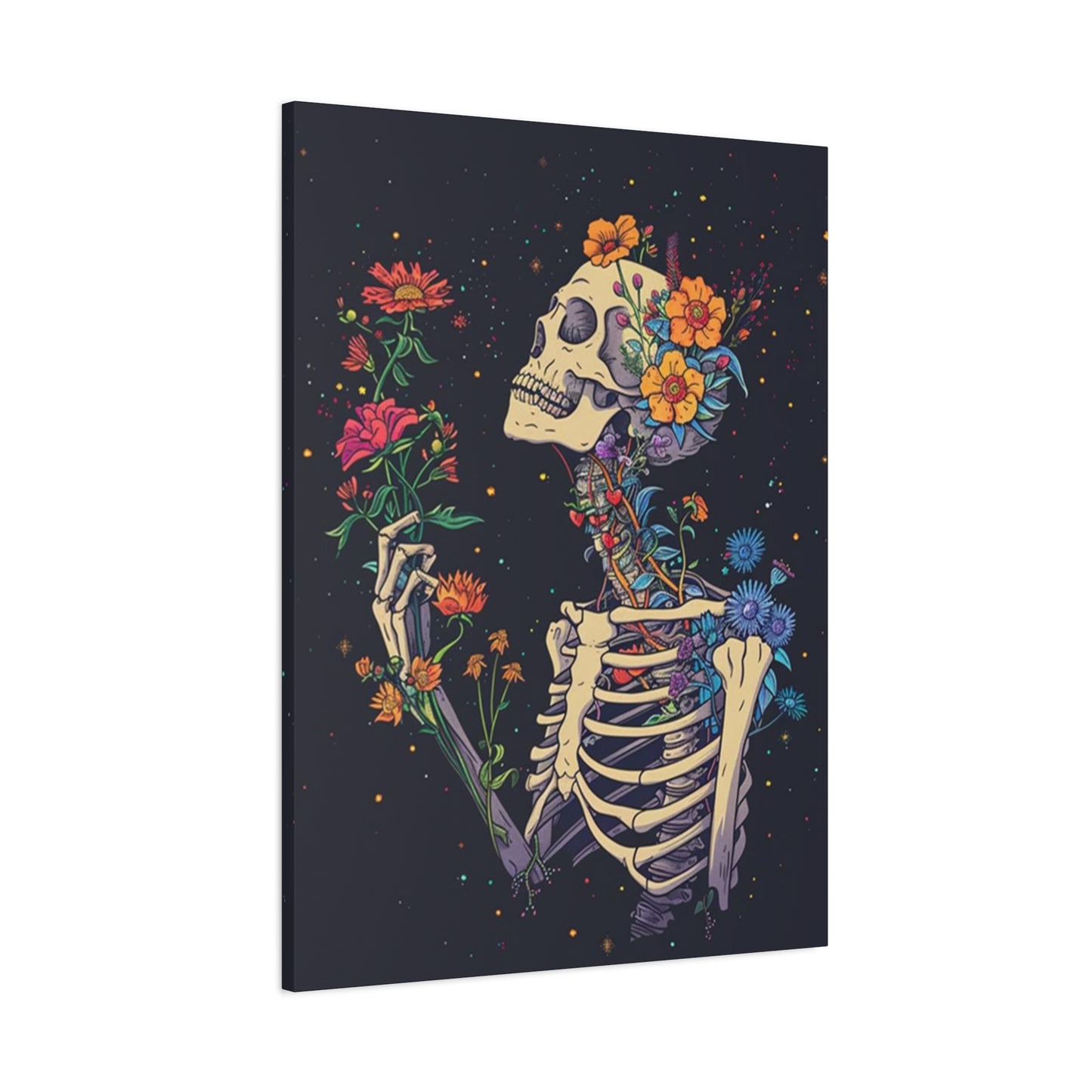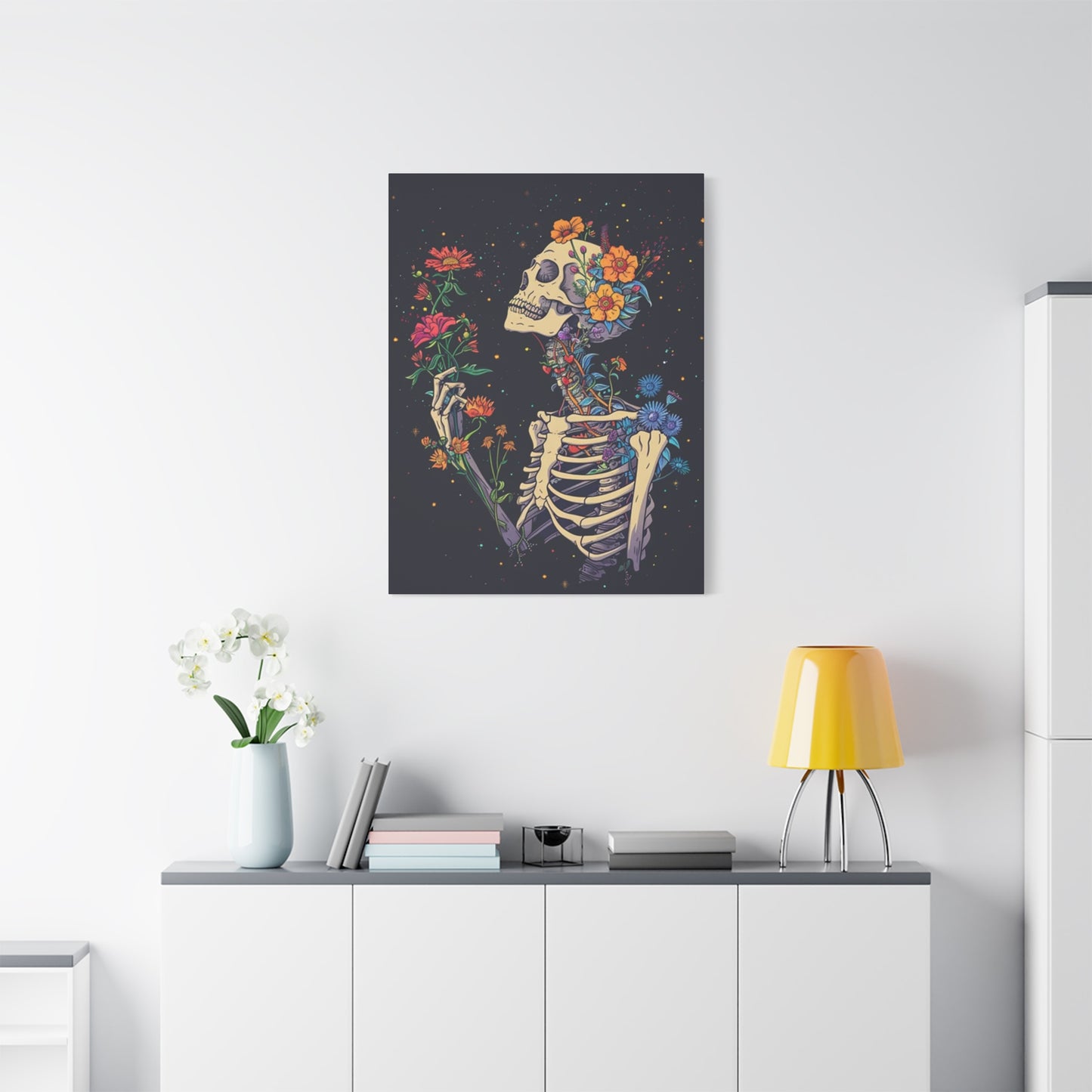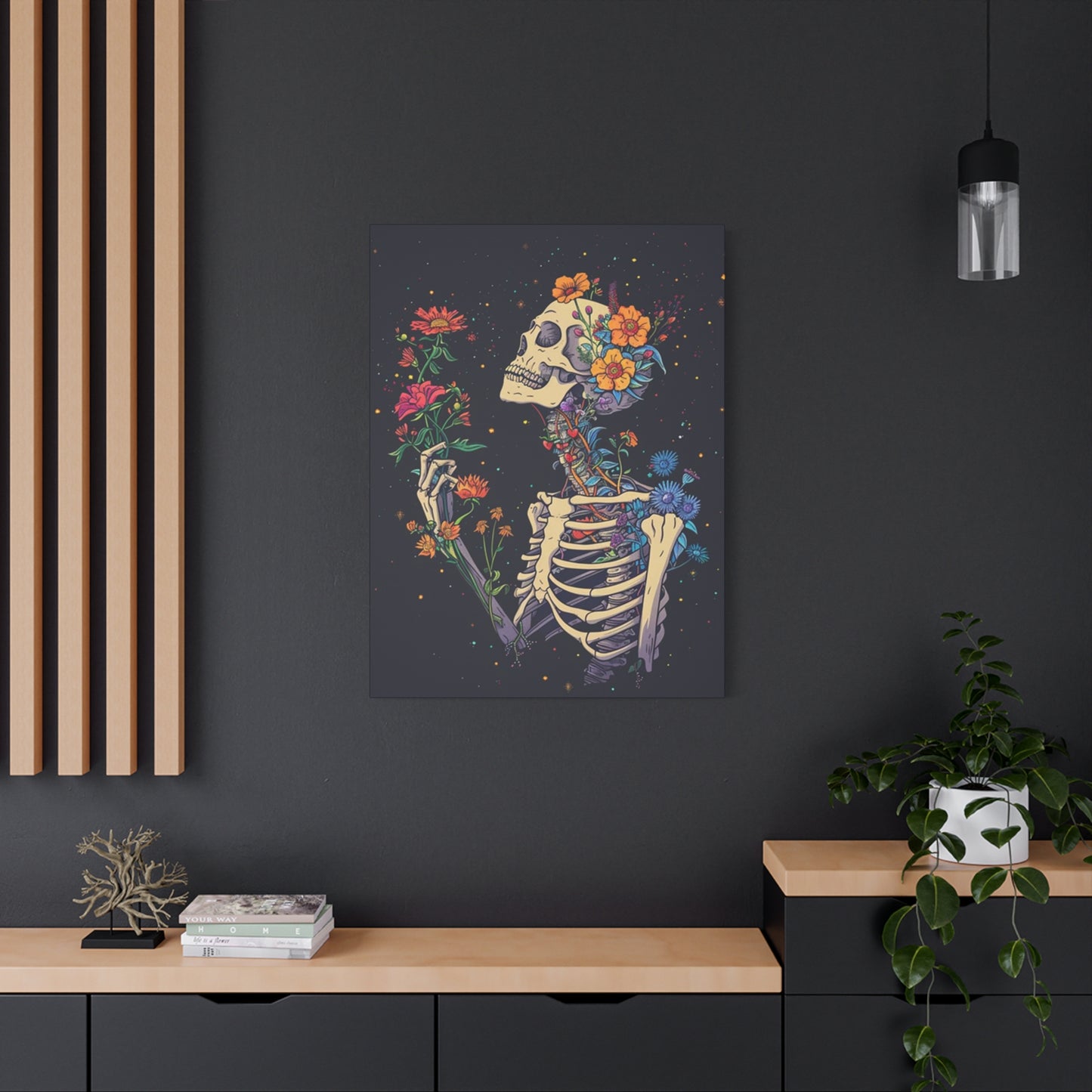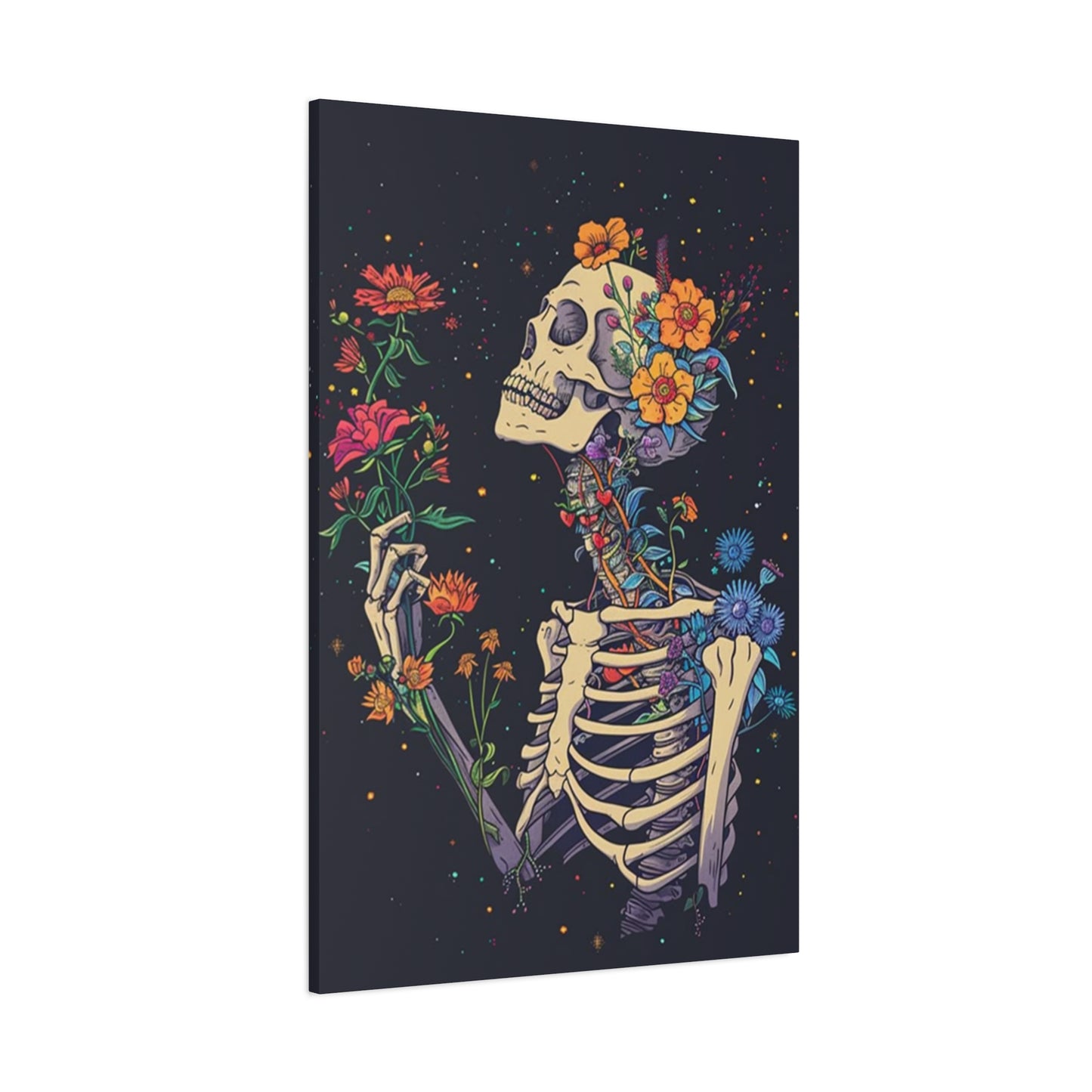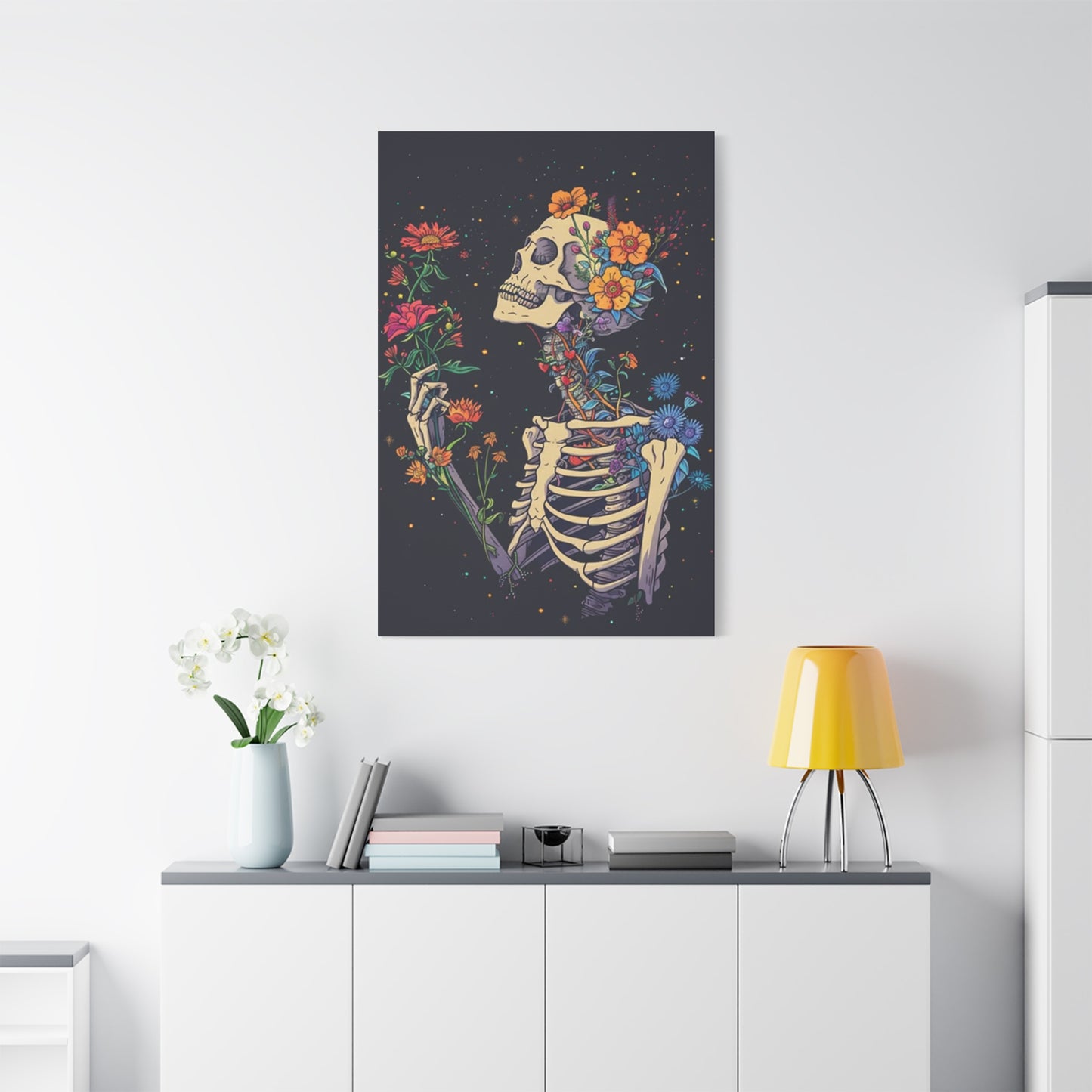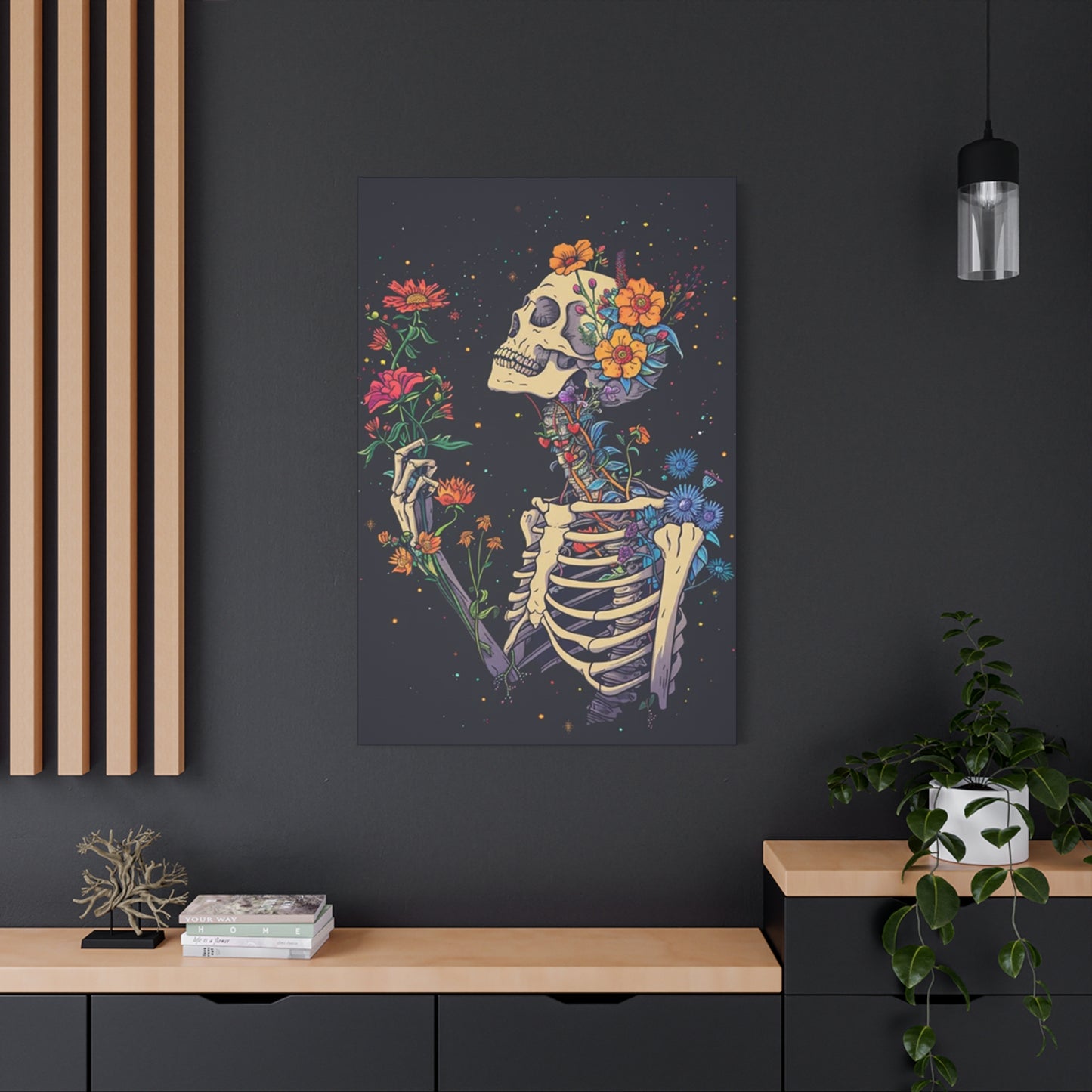Skeleton Flower Wall Art: Embracing the Harmony of Mortality and Beauty
The fascinating world of skeleton flower wall art represents one of the most compelling artistic movements in contemporary home decoration. This unique genre combines the haunting imagery of human bones with delicate floral elements, creating pieces that challenge our perceptions of beauty, mortality, and artistic expression. These striking artworks have gained tremendous popularity among those seeking to add depth, meaning, and visual intrigue to their living environments.
The appeal of skeleton flower wall art lies in its ability to juxtapose seemingly opposing elements - the finality of death represented by bones and skulls, paired with the ephemeral beauty of blooming flowers. This artistic contrast creates a powerful visual narrative that speaks to the cyclical nature of existence, the beauty found in impermanence, and the profound connection between life and death that has fascinated humanity throughout history.
Modern homeowners and art enthusiasts are increasingly drawn to these pieces because they offer something beyond conventional decorative options. They provide conversation starters, emotional depth, and a unique aesthetic that can transform any room from ordinary to extraordinary. The skeleton flower wall art movement encompasses various styles, from delicate watercolor renditions to bold graphic prints, ensuring there's a perfect piece for every taste and home aesthetic.
The Captivating Appeal of Mortality Meets Bloom
The extraordinary magnetism of flower-adorned skeletal imagery stems from its profound psychological impact on viewers. These artworks tap into fundamental human experiences and emotions, creating an immediate visual tension that both attracts and challenges the observer. The combination of death symbolism with life-affirming floral elements creates a unique artistic dialogue that resonates on multiple levels.
When examining why these pieces hold such captivating power, we must consider the deep-rooted human fascination with mortality and beauty. Throughout history, cultures worldwide have explored themes of life and death through art, literature, and spiritual practices. Skeleton flower wall art continues this tradition in a contemporary context, offering viewers a safe way to contemplate these universal themes while enjoying aesthetic beauty.
The visual impact of seeing delicate roses emerging from eye sockets, or vibrant peonies blooming from ribcages, creates an immediate emotional response. This reaction is both visceral and contemplative, forcing viewers to reconcile their associations with death and decay against the backdrop of natural beauty and renewal. The artistic tension generated by this juxtaposition makes these pieces impossible to ignore and difficult to forget.
Furthermore, the appeal extends beyond mere shock value or gothic aesthetics. These artworks often carry hopeful messages about transformation, renewal, and the continuity of beauty even in the face of mortality. They suggest that death is not an ending but rather a transformation, with new life and beauty emerging from what was once considered final. This optimistic interpretation makes skeleton flower wall art particularly meaningful for those who appreciate art that carries deeper philosophical implications.
The growing popularity of this art form also reflects broader cultural shifts toward acceptance of alternative aesthetics and non-traditional beauty standards. As society becomes more open to diverse forms of artistic expression, skeleton flower wall art has found its place among sophisticated collectors and casual art lovers alike.
Aesthetic Harmony Between Darkness and Light
The masterful balance achieved in skeleton flower wall art between dark and light elements creates a sophisticated aesthetic that appeals to diverse artistic sensibilities. This careful equilibrium transforms what could be purely macabre imagery into something beautiful, thought-provoking, and suitable for refined home environments. The artistic challenge lies in maintaining this delicate balance while ensuring neither element overshadows the other.
Artists working in this medium must possess exceptional skill in color theory, composition, and symbolic representation. The darkness inherent in skeletal imagery must be tempered with the lightness and vibrancy of floral elements, creating harmony rather than conflict. This balance is achieved through various techniques, including color selection, positioning, and the integration of elements that bridge the gap between the two opposing themes.
The sophisticated appeal of these pieces lies in their ability to present challenging subject matter in an aesthetically pleasing format. The skeleton provides structure and dramatic impact, while the flowers soften the harsh edges and introduce elements of beauty, fragrance, and life. This combination creates artworks that are simultaneously edgy and elegant, dark and beautiful, challenging and accessible.
Color plays a crucial role in achieving this aesthetic balance. Deep, rich colors like burgundy, forest green, and midnight blue often serve as transitional elements between the stark bones and vibrant flowers. These intermediate tones help create visual coherence while maintaining the dramatic contrast that makes these pieces so compelling. The skillful use of shading and highlighting further enhances the three-dimensional quality of both skeletal and floral elements.
The positioning and integration of flowers within or around skeletal structures require careful consideration of natural growth patterns and anatomical accuracy. The most successful pieces in this genre show flowers growing in ways that appear organic and believable, as if nature itself has reclaimed these remnants of mortality. This naturalistic approach enhances the artwork's credibility and emotional impact, making the impossible seem plausible and beautiful.
Contemporary Artistic Expression Through Contrasting Themes
Modern skeleton flower wall art represents a significant evolution in contemporary artistic expression, challenging traditional boundaries between beauty and macabre, life and death, delicate and strong. This artistic movement reflects broader cultural shifts toward accepting complexity, embracing paradox, and finding beauty in unexpected places. Contemporary artists working in this medium push creative boundaries while maintaining accessibility to diverse audiences.
The artistic techniques employed in creating these pieces vary widely, from traditional painting methods to digital manipulation, photography, and mixed media approaches. Each technique brings unique qualities to the final artwork, allowing artists to explore different aspects of the skeleton flower theme. Watercolor techniques might emphasize the ethereal quality of both bones and blossoms, while bold graphic approaches might focus on dramatic contrasts and strong visual impact.
Digital art has opened new possibilities for skeleton flower wall art, allowing artists to create impossibly detailed and precisely composed pieces. Digital manipulation enables the seamless integration of photographic elements with artistic interpretation, creating hyper-realistic pieces that blur the line between photography and illustration. These technological advances have expanded the artistic vocabulary available to creators while maintaining the emotional and symbolic power of the medium.
The contemporary approach to skeleton flower wall art often incorporates elements from various artistic movements, including surrealism, gothic revival, botanical illustration, and pop art. This eclectic mixing of influences creates pieces that feel both familiar and innovative, accessible yet challenging. The result is artwork that speaks to contemporary sensibilities while drawing on timeless themes and symbols.
Artists today also have access to a broader range of materials and printing techniques, allowing for unprecedented quality and durability in reproductions. High-quality giclée prints can capture every detail of original artworks, making these pieces accessible to a wider audience while maintaining artistic integrity. This democratization of art has contributed significantly to the growing popularity of skeleton flower wall art.
Visual Impact in Modern Home Environments
The integration of skeleton flower wall art into contemporary living environments requires careful consideration of existing decor, color schemes, and the emotional atmosphere desired in each room. These powerful pieces can serve as focal points that anchor entire design schemes or as accent pieces that add depth and interest to established decorative themes. Understanding how to effectively incorporate these artworks enhances their impact while ensuring harmony within the overall design aesthetic.
When selecting skeleton flower wall art for modern homes, considerations extend beyond personal taste to include the psychological impact on daily living. These pieces can energize a room, create contemplative moods, or serve as conversation catalysts during social gatherings. The key lies in matching the intensity and style of the artwork to its intended function within the home environment.
Living rooms often benefit from larger, more dramatic skeleton flower pieces that can serve as central focal points. These artworks work particularly well above sofas, fireplaces, or in dining areas where they can spark conversation and create memorable impressions. The dramatic nature of these pieces makes them excellent choices for entertaining areas where hosts want to create distinctive and memorable environments.
Bedrooms require more careful consideration when incorporating skeleton flower wall art. While some individuals find these pieces meditative and meaningful for personal reflection, others might prefer softer interpretations or smaller pieces that provide interest without overwhelming the restful atmosphere typically desired in sleeping areas. The personal nature of bedroom decoration makes this decision highly individual.
Home offices and creative workrooms often provide ideal environments for skeleton flower wall art, as these pieces can inspire creativity while providing visual interest during long work sessions. The symbolic representation of transformation and renewal can be particularly motivating for creative professionals and entrepreneurs who appreciate art with deeper meaning and personal significance.
Symbolic Interpretations and Cultural Significance
The rich symbolism inherent in skeleton flower wall art draws from diverse cultural traditions, philosophical concepts, and universal human experiences. Understanding these symbolic layers enhances appreciation for these artworks while providing insight into their growing cultural significance. The combination of death imagery with life-affirming floral elements creates a complex symbolic language that speaks to fundamental aspects of human existence.
In many cultures, skulls and skeletons represent not just death but transformation, wisdom, and the impermanence of physical existence. When combined with flowers, which traditionally symbolize beauty, growth, and the cycle of life, the resulting imagery suggests themes of renewal, hope, and the continuity of beauty beyond physical death. This positive interpretation transforms potentially morbid imagery into uplifting artistic statements about the nature of existence.
The Victorian era's fascination with mourning art and memento mori provides historical context for contemporary skeleton flower wall art. Victorian artists frequently combined death imagery with natural elements to create beautiful remembrances of deceased loved ones and meditations on mortality. Modern skeleton flower art continues this tradition while updating the aesthetic for contemporary sensibilities and living environments.
Different flowers carry specific symbolic meanings that add layers of interpretation to skeleton flower wall art. Roses might represent eternal love transcending death, while lilies could symbolize rebirth and renewal. Poppies might reference memory and sacrifice, and cherry blossoms could represent the beauty and impermanence of life. Artists often select specific flowers to enhance the symbolic message of their work.
The Day of the Dead tradition from Mexican culture has significantly influenced contemporary skeleton flower art, particularly in its celebration of death as a natural part of life rather than something to be feared. This cultural perspective transforms skeletal imagery from something frightening into something celebratory and beautiful, contributing to the mainstream acceptance of skeleton flower wall art.
Gothic Aesthetic Meets Contemporary Elegance
The evolution of skeleton flower wall art from purely gothic imagery to sophisticated contemporary elegance represents a significant artistic development that has broadened the appeal of this genre. Modern interpretations maintain the dramatic impact of traditional gothic aesthetics while incorporating refined artistic techniques and contemporary design sensibilities that make these pieces suitable for sophisticated home environments.
Contemporary artists working in this medium have mastered the art of creating pieces that feel both edgy and elegant, dark and beautiful, challenging and refined. This sophisticated approach involves careful attention to color palettes, artistic techniques, and compositional elements that elevate the artwork beyond simple shock value or gothic cliché. The result is art that can hold its own in upscale galleries while remaining accessible to everyday art lovers.
The refinement of gothic elements in skeleton flower wall art often involves softening harsh contrasts while maintaining dramatic impact. This might involve using muted color palettes that suggest rather than shout, incorporating subtle textures that add visual interest without overwhelming, or employing classical compositional techniques that bring order and beauty to potentially chaotic imagery.
Elegant approaches to skeleton flower wall art frequently emphasize the artistic and technical skill required to create believable integration between skeletal and floral elements. The most sophisticated pieces in this genre demonstrate mastery of anatomy, botanical accuracy, and artistic composition that elevates them to fine art status. This technical excellence contributes to the growing acceptance of skeleton flower art in serious artistic circles.
The contemporary elegance achieved in modern skeleton flower wall art also reflects broader trends in art and design toward complexity, sophistication, and emotional depth. Today's consumers seek art that provides more than simple decoration; they want pieces that engage intellectually, emotionally, and aesthetically. Skeleton flower wall art meets these demands while offering unique visual impact.
Decorative Applications and Styling Approaches
Successfully incorporating skeleton flower wall art into home environments requires understanding various styling approaches and decorative applications that maximize visual impact while maintaining harmony with existing design elements. These versatile pieces can adapt to multiple decorative themes, from minimalist modern to maximalist eclectic, when properly selected and positioned within the home environment.
The monochromatic approach to styling skeleton flower wall art emphasizes dramatic contrast within a limited color palette, creating sophisticated visual impact without overwhelming other design elements. Black and white pieces work particularly well in this context, providing strong focal points while maintaining versatility across different decorative themes. Sepia-toned pieces offer similar benefits while adding warmth and vintage appeal.
Colorful skeleton flower wall art requires more careful integration with existing color schemes but offers greater opportunity for creating cohesive design themes. Pieces that incorporate colors already present in furnishings, textiles, or accessories create natural harmony while adding the dramatic interest that makes these artworks so compelling. The key lies in balancing the intensity of the artwork with other design elements.
Gallery wall arrangements featuring multiple skeleton flower pieces can create powerful artistic statements while allowing for greater creative flexibility in arrangement and scale. Mixed sizing and complementary pieces can tell visual stories while providing opportunities to introduce variety in artistic style and technique. These arrangements work particularly well in larger rooms or areas where dramatic impact is desired.
The framing and presentation of skeleton flower wall art significantly impact its integration within home environments. Traditional frames might emphasize classical elements, while modern frameless presentations can enhance contemporary appeal. The choice of matting, frame materials, and mounting techniques should complement both the artwork and the surrounding decor while ensuring proper preservation of the piece.
Lighting considerations play crucial roles in maximizing the impact of skeleton flower wall art. These pieces often benefit from dramatic lighting that emphasizes contrast and detail while creating appropriate mood and atmosphere. Track lighting, picture lights, or strategically placed accent lighting can transform good pieces into stunning focal points.
Modern Artistic Movement and Cultural Impact
The emergence of skeleton flower wall art as a recognized artistic movement reflects broader cultural shifts toward accepting alternative aesthetics, embracing complexity, and finding beauty in unexpected combinations. This movement has gained momentum through social media, online art communities, and changing attitudes toward death, mortality, and artistic expression in contemporary society.
The digital age has played a crucial role in the development and spread of skeleton flower wall art, providing platforms for artists to share their work, connect with audiences, and build communities around this unique artistic genre. Online galleries, social media platforms, and digital marketplaces have democratized access to these artworks while enabling artists to reach global audiences without traditional gallery representation.
Contemporary culture's increasing comfort with alternative aesthetics has contributed significantly to the mainstream acceptance of skeleton flower wall art. As tattoo culture has become more accepted, gothic and alternative fashion has gained popularity, and non-traditional beauty standards have emerged, artwork that once might have been considered too edgy for mainstream consumption has found broad appeal.
The therapeutic and psychological benefits associated with contemplating mortality through art have contributed to the cultural significance of skeleton flower wall art. Many individuals find these pieces helpful for processing grief, celebrating life, or simply contemplating the deeper aspects of human existence. This therapeutic dimension adds meaningful depth to what might otherwise be purely decorative purchases.
The influence of skeleton flower wall art extends beyond home decoration into fashion, product design, and commercial applications. The distinctive aesthetic has appeared on clothing, accessories, home goods, and various consumer products, indicating its significant cultural penetration and commercial appeal. This broad adoption suggests the lasting power of this artistic movement.
Artistic Techniques and Creative Processes
The creation of compelling skeleton flower wall art requires mastery of diverse artistic techniques, from traditional illustration and painting methods to contemporary digital manipulation and mixed media approaches. Understanding these creative processes provides insight into the skill and artistry required to produce pieces that successfully balance the complex symbolic and aesthetic demands of this unique genre.
Traditional painting techniques used in skeleton flower wall art often emphasize detailed anatomical accuracy combined with botanical precision, requiring artists to possess knowledge of both human anatomy and plant structure. Watercolor techniques might be employed to create ethereal, dreamlike qualities, while oil painting allows for rich color saturation and detailed texture work that brings both skeletal and floral elements to life with startling realism.
Digital art creation has revolutionized skeleton flower wall art by enabling artists to achieve impossible precision in combining photographic elements with artistic interpretation. Digital manipulation allows for seamless integration of multiple source materials while maintaining complete creative control over lighting, color, and composition. These techniques enable artists to create hyper-realistic pieces that challenge viewers' perceptions of what is real and what is artistic interpretation.
Mixed media approaches to skeleton flower wall art incorporate various materials and techniques to create unique textural and visual effects. These might include collage elements, three-dimensional additions, metallic accents, or unconventional materials that add tactile interest and visual complexity. Mixed media pieces often possess unique qualities that cannot be achieved through traditional artistic methods alone.
The sketching and planning process for skeleton flower wall art typically involves extensive preparation, including anatomical studies, botanical reference gathering, and compositional planning. Artists must carefully consider how skeletal and floral elements will interact, ensuring natural integration while maintaining the dramatic impact that defines this genre. This preparatory work often determines the success of the final piece.
Color theory plays a crucial role in skeleton flower wall art creation, as artists must balance the inherent darkness of skeletal imagery with the vibrancy typically associated with floral elements. Understanding how different colors interact, influence mood, and create visual hierarchy enables artists to create pieces that are both dramatically impactful and aesthetically pleasing.
Psychological and Emotional Resonance
The profound psychological impact of skeleton flower wall art stems from its ability to engage viewers on multiple emotional and intellectual levels simultaneously. These artworks tap into fundamental human experiences including mortality awareness, beauty appreciation, transformation concepts, and the complex relationships between life and death that define human existence.
The initial shock or surprise many viewers experience when encountering skeleton flower wall art often gives way to deeper contemplation and emotional engagement. This progression from immediate reaction to thoughtful reflection creates lasting impressions and meaningful connections between viewers and artworks. The psychological journey induced by these pieces contributes significantly to their memorability and impact.
For many individuals, skeleton flower wall art serves as a meditation on mortality that feels safe and beautiful rather than morbid or frightening. The floral elements provide comfort and beauty that balance the challenging aspects of death imagery, creating artworks that encourage contemplation rather than avoidance. This psychological safety makes these pieces accessible to broader audiences than purely macabre imagery might achieve.
The transformative symbolism inherent in skeleton flower wall art resonates particularly strongly with individuals experiencing major life changes, loss, or personal growth. These artworks can provide visual metaphors for renewal, hope, and the continuity of beauty beyond physical endings. This symbolic support contributes to the therapeutic value many individuals find in these pieces.
The emotional complexity of skeleton flower wall art allows different viewers to find different meanings and emotional connections within the same piece. This interpretive flexibility ensures that these artworks remain personally relevant and emotionally engaging over time, contributing to their value as long-term decorative and meaningful additions to home environments.
Cultural Evolution and Historical Context
The historical roots of skeleton flower wall art can be traced through various cultural traditions and artistic movements that have explored themes of mortality, beauty, and transformation throughout human history. Understanding this cultural evolution provides valuable context for appreciating the contemporary significance and artistic development of this unique genre.
Ancient civilizations frequently incorporated death imagery into their artistic expressions, often combined with symbols of renewal and ongoing life. Egyptian tomb art, Aztec religious imagery, and medieval European memento mori all contributed to the cultural foundation that supports contemporary skeleton flower wall art. These historical precedents demonstrate the enduring human fascination with mortality themes in artistic expression.
The Victorian era's elaborate mourning customs and memorial art practices provided direct inspiration for modern skeleton flower wall art. Victorian artists created beautiful and meaningful artworks that combined death imagery with natural elements, establishing aesthetic and symbolic precedents that contemporary artists continue to explore and develop. Hair art, mourning jewelry, and memorial photography all contributed to this tradition.
The Mexican Day of the Dead celebration has significantly influenced contemporary skeleton flower wall art, particularly in its joyful and celebratory approach to death imagery. This cultural tradition transforms skulls and skeletons from symbols of fear into symbols of celebration, memory, and ongoing connection with deceased loved ones. This positive cultural context has contributed to mainstream acceptance of skeletal imagery in art.
The gothic revival movement of the 18th and 19th centuries established aesthetic frameworks that continue to influence skeleton flower wall art. Gothic architecture, literature, and art emphasized the beauty that could be found in darkness, decay, and mortality, creating cultural acceptance for artworks that might otherwise be considered too challenging for mainstream consumption.
Contemporary art movements including surrealism, pop art, and postmodern artistic expression have all contributed to the development of skeleton flower wall art as a recognized artistic genre. These movements established precedents for combining disparate elements, challenging conventional beauty standards, and finding artistic meaning in unexpected juxtapositions.
Commercial Applications and Market Development
The growing commercial success of skeleton flower wall art reflects its expanding cultural acceptance and demonstrates the significant market demand for artworks that provide emotional depth, visual impact, and meaningful symbolic content. This commercial development has created opportunities for artists while making these distinctive pieces accessible to broader audiences through various retail channels and price points.
Online marketplaces have played crucial roles in the commercial development of skeleton flower wall art by connecting artists with global audiences and providing platforms for discovering and purchasing these unique pieces. Digital storefronts enable artists to reach customers who might never encounter their work through traditional gallery channels, democratizing access to both artistic expression and art collection.
The reproduction market for skeleton flower wall art has developed sophisticated approaches to maintaining artistic quality while achieving affordable pricing. High-quality printing technologies, including giclée and fine art reproduction methods, ensure that printed versions of original artworks maintain visual impact and artistic integrity. This accessibility has contributed significantly to the genre's mainstream adoption.
Custom commissioned skeleton flower wall art has become a growing market segment as individuals seek personalized pieces that reflect their specific aesthetic preferences, symbolic interests, or memorial needs. Artists working in this market often create pieces that incorporate specific flowers, color schemes, or symbolic elements that hold personal meaning for clients, adding individual significance to already meaningful artistic themes.
The licensing and product development market for skeleton flower wall art has expanded to include various consumer products, from textiles and home accessories to clothing and personal items. This commercial expansion indicates the broad appeal and marketability of the aesthetic while introducing these artistic themes to new audiences who might not initially consider purchasing wall art.
Gallery representation for skeleton flower wall art has evolved from alternative and gothic-focused venues to include mainstream contemporary art galleries, indicating the growing artistic credibility and market acceptance of this genre. This gallery presence contributes to artistic legitimacy while providing additional sales channels for established and emerging artists.
Technological Innovation in Creation and Distribution
Technological advances have revolutionized both the creation and distribution of skeleton flower wall art, enabling new artistic possibilities while expanding access to these distinctive pieces. Digital tools, printing technologies, and online platforms have transformed how artists work and how consumers discover and purchase skeleton flower wall art.
Digital illustration software has provided artists with unprecedented control over the creation process, enabling precise manipulation of anatomical and botanical elements while maintaining complete creative freedom. These tools allow for experimentation with colors, compositions, and effects that would be difficult or impossible to achieve through traditional artistic methods, expanding the creative vocabulary available to artists working in this genre.
High-resolution scanning and photography technologies enable artists to create hybrid works that combine traditional artistic techniques with digital manipulation, resulting in pieces that possess the warmth and texture of traditional art with the precision and flexibility of digital creation. This technological fusion has produced some of the most compelling examples of contemporary skeleton flower wall art.
Print-on-demand technologies have revolutionized the distribution of skeleton flower wall art by eliminating inventory requirements while maintaining high quality standards. Artists can offer their work in multiple formats and sizes without upfront investment, while consumers can access exactly the size and format needed for their specific decorative requirements. This flexibility has contributed significantly to market growth.
Social media platforms and digital marketing tools have enabled artists to build audiences, share creative processes, and connect directly with collectors and fans. These platforms provide opportunities for artistic education, community building, and direct sales that bypass traditional gallery systems while maintaining artistic control and higher profit margins for creators.
Virtual and augmented reality technologies are beginning to influence how consumers preview and select skeleton flower wall art for their homes. These tools enable potential buyers to visualize artworks in their actual living environments before purchase, reducing uncertainty and increasing customer satisfaction while potentially expanding market reach to hesitant buyers.
Regional Variations and Cultural Adaptations
The global appeal of skeleton flower wall art has resulted in fascinating regional variations and cultural adaptations that reflect local artistic traditions, cultural values, and aesthetic preferences while maintaining the fundamental symbolic and visual elements that define this genre. These variations demonstrate the universal appeal of the themes while celebrating diverse cultural approaches to artistic expression.
European interpretations of skeleton flower wall art often emphasize classical artistic techniques and traditional botanical accuracy, reflecting the continent's rich art historical traditions and cultural appreciation for technical skill. These pieces might incorporate flowers native to specific regions or reference historical artistic movements that resonate within particular cultural contexts, creating works that feel both globally relevant and locally meaningful.
Asian adaptations of skeleton flower wall art frequently incorporate elements from traditional art forms, including calligraphy, ink painting techniques, and culturally significant flowers such as cherry blossoms, lotuses, or chrysanthemums. These cultural elements add layers of meaning while creating artworks that resonate particularly strongly with Asian audiences and collectors interested in cultural fusion.
North American skeleton flower wall art often reflects the continent's cultural diversity and artistic innovation, incorporating influences from various immigrant cultures while developing distinctly American aesthetic approaches. These pieces might combine Native American symbolic elements, Mexican Day of the Dead influences, and contemporary urban artistic styles to create uniquely American interpretations of the genre.
Latin American contributions to skeleton flower wall art draw heavily from rich cultural traditions surrounding death, celebration, and artistic expression. The influence of Día de los Muertos aesthetics, combined with tropical floral elements and vibrant color palettes, creates artworks that celebrate life and death with particular joy and cultural authenticity.
African interpretations of skeleton flower wall art often incorporate traditional artistic techniques, native flowers, and cultural symbolic elements that reflect the continent's diverse artistic heritage. These pieces might reference traditional mask-making, textile patterns, or ceremonial art forms while addressing universal themes of mortality and renewal through distinctly African cultural lenses.
Educational Value and Artistic Appreciation
Skeleton flower wall art provides significant educational opportunities for developing artistic appreciation, understanding cultural traditions, and exploring complex philosophical themes through visual art. These pieces serve as excellent starting points for discussions about art history, cultural studies, symbolism, and the role of art in processing difficult emotions and concepts.
The artistic techniques employed in creating skeleton flower wall art offer educational insights into various artistic methods, from traditional painting and illustration to contemporary digital art and mixed media approaches. Studying these pieces can help art students and enthusiasts understand how different techniques contribute to overall artistic impact and emotional resonance.
The cultural and historical contexts surrounding skeleton flower wall art provide rich educational content for understanding how different societies have approached mortality, memory, and artistic expression throughout history. These connections help viewers appreciate contemporary artworks within broader cultural contexts while understanding the evolution of artistic themes and techniques.
The symbolic complexity of skeleton flower wall art offers opportunities for developing critical thinking skills and symbolic interpretation abilities. Viewers can learn to recognize and analyze symbolic elements while understanding how artists use visual metaphors to communicate complex ideas and emotions through their work.
The therapeutic and psychological aspects of skeleton flower wall art provide educational opportunities for understanding how art can serve emotional and mental health needs. These pieces demonstrate art's capacity to help individuals process difficult emotions, contemplate mortality, and find beauty in challenging circumstances.
Future Trends and Artistic Development
The continued evolution of skeleton flower wall art suggests several future trends and developmental directions that will likely influence both artistic creation and market development in this distinctive genre. Understanding these potential developments provides insight into the ongoing significance and growth potential of this unique artistic movement.
Technological integration will likely continue expanding the creative possibilities for skeleton flower wall art, with virtual reality, artificial intelligence, and advanced digital tools enabling new forms of artistic expression and viewer interaction. These technologies might enable immersive experiences that allow viewers to explore artworks in three-dimensional environments or customize pieces according to personal preferences.
Sustainability concerns are increasingly influencing art production and consumption, suggesting future developments in eco-friendly materials, sustainable printing methods, and environmentally conscious artistic practices. These considerations will likely impact how skeleton flower wall art is created, reproduced, and distributed while appealing to environmentally conscious consumers.
The therapeutic applications of skeleton flower wall art may expand as understanding of art therapy and psychological benefits of artistic contemplation grows. This could lead to specialized collections designed for healthcare environments, grief counseling services, or mental health applications that utilize the unique psychological properties of these artworks.
Cross-cultural fusion will likely continue developing as global communication and cultural exchange expand, creating new hybrid styles that combine elements from various cultural traditions while maintaining the fundamental appeal of skeleton flower wall art. These developments will contribute to the genre's continued evolution and global relevance.
The democratization of art creation through digital tools and online platforms suggests that skeleton flower wall art will continue attracting new artists and expanding in stylistic diversity, ensuring ongoing innovation and fresh perspectives within the genre while maintaining its core symbolic and aesthetic appeals.
Conclusion
Skeleton flower wall art represents a remarkable fusion of mortality and beauty that speaks to fundamental human experiences while providing exceptional decorative and emotional value for contemporary homes and collectors. This unique artistic genre has successfully bridged the gap between challenging symbolic content and accessible aesthetic appeal, creating artworks that serve multiple functions as decorative elements, conversation catalysts, and meaningful artistic statements.
The evolution of skeleton flower wall art from niche gothic imagery to mainstream artistic acceptance demonstrates the power of skilled artistic execution and meaningful symbolic content to transcend conventional aesthetic boundaries. These pieces prove that art can successfully combine seemingly opposing elements to create harmony, beauty, and emotional resonance that enriches daily living experiences while providing opportunities for contemplation and personal growth.
The technical skill required to create compelling skeleton flower wall art, combined with the deep symbolic content these pieces carry, elevates this genre beyond simple decorative art to meaningful artistic expression that can hold lasting personal and cultural significance. The careful balance between darkness and light, mortality and beauty, challenge and accessibility creates artworks that reward both casual observation and serious contemplation.
The commercial success and cultural acceptance of skeleton flower wall art indicate its enduring appeal and suggest continued growth and development in the coming years. As society becomes increasingly comfortable with alternative aesthetics and complex artistic themes, these pieces are likely to maintain their relevance while attracting new audiences and inspiring continued artistic innovation within the genre.
The educational and therapeutic values inherent in skeleton flower wall art add dimensions of meaning that extend far beyond simple home decoration, making these pieces valuable additions to various environments including homes, offices, healthcare facilities, and educational institutions. The ability of these artworks to facilitate important conversations about mortality, beauty, and transformation makes them particularly valuable in our contemporary cultural context.
For those considering adding skeleton flower wall art to their collections or homes, the wide variety of styles, techniques, and symbolic approaches available ensures that suitable pieces exist for virtually any aesthetic preference or symbolic interest. Whether seeking dramatic focal points, subtle accent pieces, or meaningful artistic statements, skeleton flower wall art offers unique solutions that combine visual impact with emotional depth and cultural significance.
The future of skeleton flower wall art appears bright, with continuing technological innovations, expanding cultural acceptance, and growing artistic sophistication all contributing to the genre's ongoing development and relevance. As new artists enter the field and established practitioners continue pushing creative boundaries, we can expect continued evolution and innovation within this distinctive artistic movement.
The lasting impact of skeleton flower wall art lies in its ability to transform challenging subjects into beautiful, meaningful, and accessible artistic expressions that enrich our understanding of mortality, beauty, and the complex relationships between life and death that define human existence. These remarkable artworks continue to prove that skilled artists can find beauty in unexpected places while creating lasting value for collectors and art lovers worldwide.

















